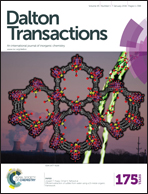Synthesis and structures of mononuclear and dinuclear gallium complexes with α-diimine ligands: reduction of the metal or ligand?†
Abstract
Reduction of the dichloro gallium(III) α-diimine complex [(Lipr)˙−GaCl2] (1, Lipr = [(2,6-iPr2C6H3)NC(Me)]2) by different equivalents of sodium metal afforded the gallium complexes [(Lipr)2−GaIII(μ2-Cl)2Na(THF)4] (2) and [(Na(THF)6)+·((Lipr)2−Ga–Ga(Lipr)2−)˙−] (3). Interestingly, in complex 2 a Na+Cl− ion pair is incorporated, while compound 3 is an anionic digallium complex. Moreover, a cationic gallium complex with a tetrachlorogallium(III) counter anion, [(LGaCl2)+·(GaCl4)−] (4), was accessed from the reaction of GaCl3 with 0.5 equiv. of ligand Lipr. In contrast, the reaction of GaCl3 with the doubly reduced anion (Na2L2−) of the smaller α-diimine ligands LMe ([(2,6-Me2C6H3)NC(Me)]2) or LEt ([(2,6-Et2C6H3)NC(Me)]2) yielded the Ga–Ga-bonded complexes [(LEt)˙−ClGaII–GaIICl(LEt)˙−] (5) and [(LMe)˙−ClGaII–GaIICl(LMe)˙−] (6). Here L is the neutral α-diimine ligand, L˙− represents the monoanion, and L2− is the dianionic form of the ligand. The complexes were characterized by X-ray diffraction and their electronic structures were studied by DFT computations.


 Please wait while we load your content...
Please wait while we load your content...